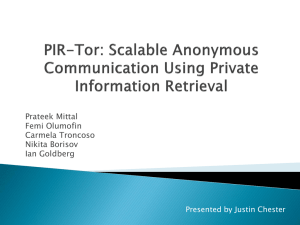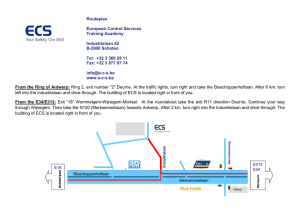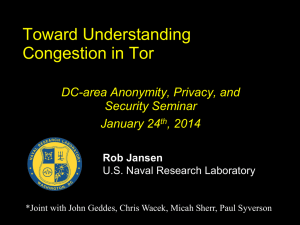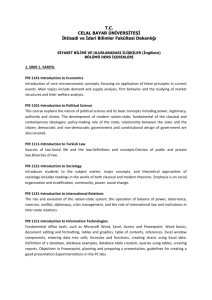PIR-Tor: Scalable Anonymous Communication Using
advertisement
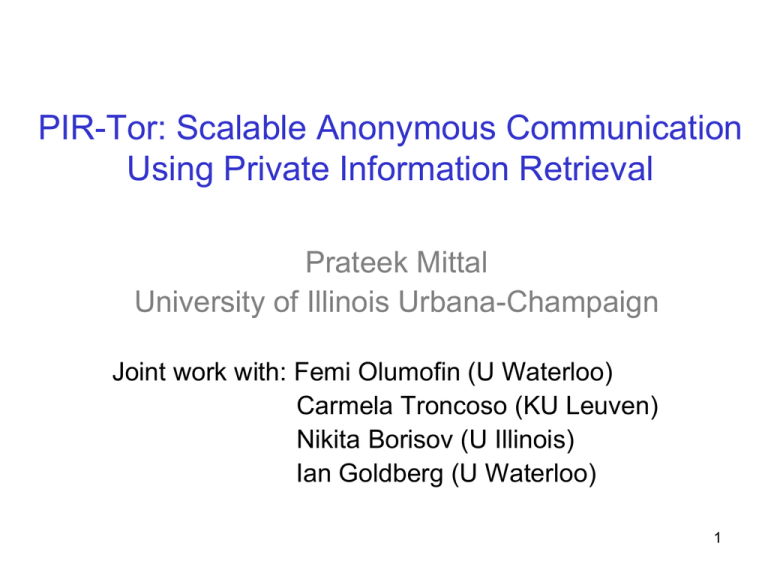
PIR-Tor: Scalable Anonymous Communication Using Private Information Retrieval Prateek Mittal University of Illinois Urbana-Champaign Joint work with: Femi Olumofin (U Waterloo) Carmela Troncoso (KU Leuven) Nikita Borisov (U Illinois) Ian Goldberg (U Waterloo) 1 Anonymous Communication • What is anonymous communication? ? Routers – Allows communication while keeping user identity (IP) secret from a third party or a recipient • Growing interest in anonymous communication – Tor is a deployed system – Spies & law enforcement, dissidents, whistleblowers, censorship resistance 2 Tor Background Directory Servers List of servers? Trusted Directory Authority Middle Signed Server list (relay descriptors) Exit Guards 1. Load balancing 2. Exit policy 3 Performance Problem in Tor’s Architecture: Global View • Global view – Not scalable Directory Servers List of servers? Need solutions without global system view Torsk – CCS09 4 Current Solution: Peer-to-peer Paradigm • Morphmix [WPES 04] – Broken [PETS 06] • Salsa [CCS 06] – Broken [CCS 08, WPES 09] • NISAN [CCS 09] – Broken [CCS 10] • Torsk [CCS 09] – Broken [CCS 10] • ShadowWalker [CCS 09] – Broken and fixed(??) [WPES 10] Very hard to argue security of a distributed, dynamic and complex P2P system. 5 Design Goals • A scalable client-server architecture with easy to analyze security properties. – Avoid increasing the attack surface • Equivalent security to Tor – Preserve Tor’s constraints • Guard/middle/exit relays, • Load balancing – Minimal changes • Only relay selection algorithm 6 Key Observation Relay # 10, 25 Directory • Need only 18 random Download selected letting directory middle/exit relaysrelay in 3descriptors hours withoutServer servers know the information we asked for. – So don’t download 2000! Bob 10: IPalladdress, key • Private Information Retrieval (PIR) IP address, • Naïve approach:25: download a key few random relays from directory servers – Problem: malicious servers 10 25 – Route fingerprinting attacks Inference: User likely to be Bob 7 Private Information Retrieval (PIR) • Information theoretic PIR – Multi-server protocol – Threshold number of servers don’t collude A B • Computational PIR – Single server protocol – Computational assumption on server C Database A • Only ITPIR-Tor in this talk – See paper for CPIR-Tor RA Database 8 ITPIR-Tor: Database Locations • Tor places significant trust in guard relays – 3 compromised guard relays suffice to undermine user anonymity in Tor. • Choose client’s guard relays to be directory ExitExit relay compromised: relay honest servers At least All guardone relays guard compromised relay is honest Equivalent security to Middle the current Tor network Middle Exit Exit Middle DenyExit Service End-to-end Timing Analysis Guards ITPIR does not provide guarantees userprivacy privacy Guards ITPIR But in this case, Tor anonymity broken Guards 9 ITPIR-Tor Database Organization and Formatting • Middles, exits Sort by Relay Bandwidth – Separate databases Descriptors • Exit policies – Standardized exit policies – Relays grouped by exit policies • Load balancing – Relays sorted by bandwidth m1 m2 m3 m4 m5 m6 m7 m8 e1 e2 e3 e4 e5 e6 e7 e8 Middles Exits Exit Policy 1 Exit Policy 2 Nonstandard Exit policies 10 ITPIR-Tor Architecture Guard relays/ PIR Directory servers Trusted Directory Authority 2. Initial connect 3. Signed meta-information 1. Download PIR database 5. 5.18 Queries(1 18PIR middle,18 PIRmiddle/exit) Query(exit) 6. PIR Response 4. Load balanced index selection m1 m2 m3 m4 m5 m6 m7 m8 e1 e2 e3 e4 e5 e6 e7 e8 Middles Exits 11 Performance Evaluation • Percy [Goldberg, Oakland 2007] – Multi-server ITPIR scheme • 2.5 GHz, Ubuntu • Descriptor size 2100 bytes – Max size in the current database • Exit database size – Half of middle database • Methodology: Vary number of relays – Total communication – Server computation 12 Performance Evaluation: Communication Overhead Advantage of PIR-Tor becomes larger due to its sublinear scaling: 100x--1000x improvement 1.1 MB 216 KB 12 KB Current Tor network: 5x--100x improvement 13 Performance Evaluation: Server Computational Overhead 100,000 relays: about 10 seconds (does not impact user latency) Current Tor network: less than 0.5 sec 14 Performance Evaluation: Scaling Scenarios Scenario Tor ITPIR ITPIR Communication Communication Core Utilization (per client) (per client) Explanation Relay Clients Current Tor 2,000 250,000 1.1 MB 0.2 MB 0.425 % 10x relay/client 20,000 2.5M 0.5 MB 4.25 % Clients turn relays 250,000 250,000 137 MB 1.7 MB 0.425 % 11 MB 15 Conclusion • PIR can be used to replace descriptor download in Tor. – Improves scalability • 10x current network size: very feasible • 100x current network size : plausible – Easy to understand security properties • Side conclusion: Yes, PIR can have practical uses! • Questions? 16
